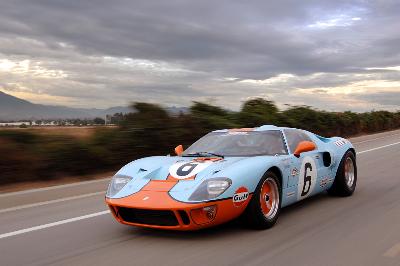Jan. 7 (Bloomberg) -- There are cars that race and then there are real race cars. I’m inside America’s most famous example of the latter: the GT40, the “Ferrari killer” of the 1960s.
The Ford GT40 MK II was the weapon that Henry Ford II and Carroll Shelby employed against Enzo Ferrari’s team in the 1966 24 Hours of Le Mans, amazingly winning the top three places. It was the first time a U.S. manufacturer had taken the ultra- prestigious race. A limited number of street-legal GT40s also were made, and today they’re very pricey collector cars.
A turn at the wheel of a GT40 is a rare, wonderful thing. Except there’s a catch: This one didn’t even exist in the ‘60s. Instead, it’s a $100,000 recreation by a company named Superformance.
Licensed by the GT40 trademark holders, Superformance calls its GT40s “continuation cars” and says they’re made using the same specifications as the originals, right down to structural welds. The company is based in Irvine, California, though the cars are produced in Port Elizabeth, South Africa.
The GT40 is sold as a “rolling chassis,” meaning the engine and transmission are installed by an outside company in the U.S. after it’s bought. Superformance says this gives it special status not unlike kit cars, bypassing federal regulations such as air bags and EPA certification.
Buyers can choose from a number of V-8 engines, including a 4.2 liter capable of 550 horsepower, as well as fuel injection or carburetor. The company arranges for outside installation and quotes a price of $90,000 to $115,000 for the full package.
Steel, Not Fiberglass
While Superformance isn’t the only company to build GT40 replicas, theirs are made of steel rather than cheap fiberglass. The company also produces licensed Shelby Cobra roadsters and a commemorative Shelby version of the GT40.
The GT40 comes in two body styles, the aggressive MK II and the slightly less radical-looking MK I. Only 40 inches tall, the MK I is low and wide, with wide fenders flanking a deep sloping hood. It also has a gaping hole in the center of the hood to suck in air.
The tops of the doors are cut into the roofline, and the windows are fixed and do not roll down. This is a mid-engine machine, and the entire rear body panel unhinges to get at it.
My test model, which I picked up at the showroom in Irvine, is a MK I in robin’s-egg blue and orange. It’s intimidating enough to give even an experienced driver pause. Will I be able to handle this thing?
A good question. The original GT40s easily made 200 miles per hour, and this version’s technology is very much grounded in the 1960s: no traction or stability control, no power steering and no antilock brakes.
‘60s Lust
Why, exactly, would you want one? Chief Executive Officer Lance Stander says most owners aren’t actually mega-rich but usually saw the original races and have lusted for one ever since. The GT40 would be a fine track vehicle even today, and Stander says there’s an amateur race series in the works.
Its charms become clear when I actually fire it up.
Last June, I reviewed the Nissan GT-R, a “supercar” bristling with electronic aids, making an average driver feel like a hero. If driving the GT-R is a digital experience, piloting the GT40 is the analog equivalent.
The rattling V-8 sends tremors throughout the entire car, and the racket would anger even the most forgiving of neighbors. There’s no interior sound deadening, and heat leaks into the cockpit from the engine. The only (very helpful) creature comfort is an air conditioner.
Fighting the Transmission
The driver’s seat is bolted down and reclined like a Barcalounger, so I have to stretch to reach the heavy clutch. The round steering wheel is tilted skyward like a bus, and getting the five-speed manual transmission into first and second is akin to fighting with an angry cat in a bag.
Still, it’s the most physical and visceral of driving experiences: I use my entire body as if handling a strong-willed horse.
Every road bump is experienced in a very personal way, the result of being so butt-draggingly close to the ground. For this reason it always seems like I’m going fast. I’d swear I was at 100 mph except for the SUV cruising serenely alongside, a child in the back waving.
Finally I get to an open road and charge through a series of twisty turns. Mid-engine cars are known for handling, and this one is no exception. Sure-footed and mostly predictable, it exhibits no nasty whipping of the tail. And the rack-and-pinion steering is as tight as a go-kart.
I mash on the gas and in a flash the GT40 charges well past 100 mph. Superformance says the car weighs only 2,400 pounds and predicts a 0 to 60 mph speed of 3.5 seconds.
Ford created its own $150,000 reprise of the GT40 in 2004, simply calling it the GT. It was fun to drive, but nothing as pure, primal and involving as this.
Tomorrow, as it turns out, I will actually be sore. No question about it: I drove the GT40, it didn’t drive me.
The Superformance GT40 at a Glance
Engine: 4.2-liter V-8 with 550 horsepower and 535 pound-feet of torque.
Transmission: five-speed manual.
Speed: 0 to 60 mph in 3.5 seconds.
Gas mileage per gallon: 13 mpg combined (estimated).
Price as tested: $100,000.
Best features: High level of driver involvement.
Worst features: Difficult driving position; troublesome manual transmission.
Target buyer: The back-to-basics lover who wants to own an American legend.
(Jason H. Harper writes about autos for Bloomberg News. The opinions expressed are his own.)
To contact the writer of this column: Jason H. Harper at jason@jasonhharper.com.
For a Dealer near you




